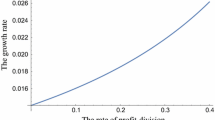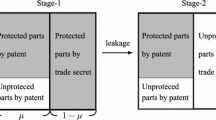Abstract
What are the effects of blocking patents on R&D and consumption? This paper develops a quality-ladder growth model with overlapping intellectual property rights and capital accumulation to quantitatively evaluate the effects of blocking patents. The analysis focuses on two policy variables (a) patent breadth that determines the amount of profits created by an invention and (b) the profit-sharing rule that determines the distribution of profits between current and former inventors along the quality ladder. The model is calibrated to aggregate data of the US economy. Under parameter values that match key features of the US economy and show equilibrium R&D underinvestment, I find that optimizing the profit-sharing rule of blocking patents would lead to a significant increase in R&D, consumption and welfare. Also, the paper derives and quantifies a dynamic distortionary effect of patent policy on capital accumulation.
Similar content being viewed by others
References
Acemoglu D. (2009) Introduction to modern economic growth. Princeton University Press, Princeton, NJ
Acemoglu, D., & Akcigit, U. (2008). State dependent intellectual property rights policy. NBER Working Paper No. 12775.
Aghion P., Howitt P. (1992) A model of growth through creative destruction. Econometrica 60: 323–351. doi:10.2307/2951599
Arnold L.G. (2006) The dynamics of the Jones R&D growth model. Review of Economic Dynamics 9: 143–152. doi:10.1016/j.red.2005.09.001
Basu S. (1996) Procyclical productivity: Increasing returns or cyclical utilization?. The Quarterly Journal of Economics 111: 719–751. doi:10.2307/2946670
Basu S., Fernald J.G. (1997) Returns to scale in U.S. production: Estimates and implications. The Journal of Political Economy 105: 249–283. doi:10.1086/262073
Caballero R.J., Jaffe A.B. (2002) How high are the giants’ shoulders: An empirical assessment of knowledge spillovers and creative destruction in a model of economic growth. In: Jaffe A., Trajtenberg M. (eds) Patents, citations and innovations: A window on the knowledge economy. The MIT Press, Cambridge, MA, pp 89–152
Chu, A. C. (2009). Effects of patent length on R&D: A quantitative DGE analysis. Institute of Economics, Academia Sinica Working Paper.
Comin D. (2004) R&D: A small contribution to productivity growth. Journal of Economic Growth 9: 391–421. doi:10.1007/s10887-004-4541-6
Futagami K., Iwaisako T. (2007) Dynamic analysis of patent policy in an endogenous growth model. Journal of Economic Theory 132: 306–334. doi:10.1016/j.jet.2005.07.009
Gallini N.T. (2002) The economics of patents: Lessons from recent U.S. patent reform. Journal of Economic Perspectives 16: 131–154
Gilbert R., Shapiro C. (1990) Optimal patent length and breadth. The Rand Journal of Economics 21: 106–112. doi:10.2307/2555497
Goh A.-T., Olivier J. (2002) Optimal patent protection in a two-sector economy. International Economic Review 43: 1191–1214. doi:10.1111/1468-2354.t01-1-00053
Green J.R., Scotchmer S. (1995) On the division of profit in sequential innovation. The Rand Journal of Economics 26: 20–33. doi:10.2307/2556033
Grossman G.M., Helpman E. (1991) Quality ladders in the theory of growth. The Review of Economic Studies 58: 43–61. doi:10.2307/2298044
Grossman G.M., Lai E. (2004) International protection of intellectual property. The American Economic Review 94: 1635–1653. doi:10.1257/0002828043052312
Guvenen F. (2006) Reconciling conflicting evidence on the elasticity of intertemporal substitution: A macroeconomic perspective. Journal of Monetary Economics 53: 1451–1472. doi:10.1016/j.jmoneco.2005.06.001
Hall B.H., Jaffe A.B., Trajtenberg M. (2002) The NBER patent citation data file: Lessons, insights and methodological tools. In: Jaffe A., Trajtenberg M. (eds) Patents, citations and innovations: A window on the knowledge economy. The MIT Press, Cambridege, MA, pp 403–459
Hopenhayn H., Llobet G., Mitchell M. (2006) Rewarding sequential innovators: Prizes, patents, and buyouts. The Journal of Political Economy 114: 1041–1068. doi:10.1086/510562
Hunt, R. M. (1999). Nonobviousness and the incentive to innovate: An economic analysis of intellectual property reform. Federal Reserve Bank of Philadelphia Working Paper 99-3.
Jaffe A.B. (2000) The U.S. patent system in transition: Policy innovation and the innovation process. Research Policy 29: 531–557
Jaffe A.B., Lerner J. (2004) Innovation and its discontents: How our broken system is endangering innovation and progress, and what to do about it. Princeton University Press, Princeton, NJ
Jones C.I. (1995a) Time series tests of endogenous growth models. The Quarterly Journal of Economics 110: 495–525. doi:10.2307/2118448
Jones C.I. (1995b) R&D-based models of economic growth. The Journal of Political Economy 103: 759–784. doi:10.1086/262002
Jones C.I. (1999) Growth: With or without scale effects. American Economic Review Papers and Proceedings 89: 139–144
Jones C.I., Williams J.C. (1998) Measuring the social return to R&D. The Quarterly Journal of Economics 113: 1119–1135. doi:10.1162/003355398555856
Jones C.I., Williams J.C. (2000) Too much of a good thing? The economics of investment in R&D. Journal of Economic Growth 5: 65–85. doi:10.1023/A:1009826304308
Judd K.L. (1985) On the performance of patents. Econometrica 53: 567–586. doi:10.2307/1911655
Klemperer P. (1990) How broad should the scope of patent protection be?. The Rand Journal of Economics 21: 113–130. doi:10.2307/2555498
Kwan Y.K., Lai E. (2003) Intellectual property rights protection and endogenous economic growth. Journal of Economic Dynamics & Control 27: 853–873. doi:10.1016/S0165-1889(02)00018-0
Laitner J. (1982) Monopoly and long-run capital accumulation. The Bell Journal of Economics 13: 143–157. doi:10.2307/3003436
Laitner J., Stolyarov D. (2004) Aggregate returns to scale and embodied technical change: Theory and measurement using stock market data. Journal of Monetary Economics 51: 191–233. doi:10.1016/j.jmoneco.2003.07.001
Lanjouw J.O. (1998) Patent protection in the shadow of infringement: Simulation estimations of patent value. The Review of Economic Studies 65: 671–710. doi:10.1111/1467-937X.00064
Li C.-W. (2001) On the policy implications of endogenous technological progress. The Economic Journal 111: 164–179. doi:10.1111/1468-0297.00626
Nordhaus W. (1969) Invention, growth, and welfare: A theoretical treatment of technological change. The MIT Press, Cambridge, MA
O’Donoghue T. (1998) A patentability requirement for sequential innovation. The Rand Journal of Economics 29: 654–679. doi:10.2307/2556088
O’Donoghue T., Scotchmer S., Thisse J.-F. (1998) Patent breadth, patent life, and the pace of technological progress. Journal of Economics & Management Strategy 7: 1–32. doi:10.1162/105864098567317
O’Donoghue T., Zweimuller J. (2004) Patents in a model of endogenous growth. Journal of Economic Growth 9: 81–123. doi:10.1023/B:JOEG.0000023017.42109.c2
Romer P.M. (1990) Endogenous technological change. The Journal of Political Economy 98: S71–S102. doi:10.1086/261725
Scotchmer S. (2004) Innovation and incentives. The MIT Press, Cambridge, MA
Segerstrom P.S. (1998) Endogenous growth without scale effects. The American Economic Review 88: 1290–1310
Shapiro, C. (2001). Navigating the patent thicket: Cross licenses, patent pools, and standard setting. In A. Jaffe, J. Lerner, & S. Stern (Eds.), Innovation policy and the economy (Vol. 1, pp. 119–150). Cambridge, MA: The MIT Press.
Steger, T. M. (2005). Non-scale models of R&D-based growth: The market solution. Topics in Macroeconomics, 5, article 3.
Tandon P. (1982) Optimal patents with compulsory licensing. The Journal of Political Economy 90: 470–486. doi:10.1086/261070
Trimborn T., Koch K.-J., Steger T.M. (2008) Multi-dimensional transitional dynamics: A simple numerical procedure. Macroeconomic Dynamics 12: 301–319. doi:10.1017/S1365100507070034
Author information
Authors and Affiliations
Corresponding author
Rights and permissions
About this article
Cite this article
Chu, A.C. Effects of blocking patents on R&D: a quantitative DGE analysis. J Econ Growth 14, 55–78 (2009). https://doi.org/10.1007/s10887-009-9036-z
Published:
Issue Date:
DOI: https://doi.org/10.1007/s10887-009-9036-z




